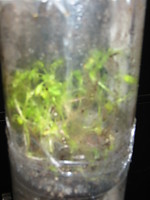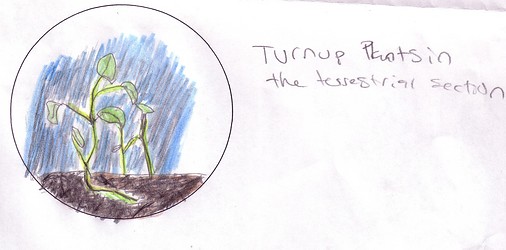Introduction
We created the ecobottles to build a little ecosystem, and we watched how everything is like a chain. If something happens to the first level something else will happen to all the other levels; when something happens to one thing there is also an effect on everything else. I think it is very interesting to watch things die off and some other things to come to life. The things that came to life were a bunch of little worms, some mold, and a few fruit flies. The things that died were a grasshopper, a fish, and a bunch of worms. It was really cool to watch because sometimes we had no idea how those things came to life. I think that we all had a lot of fun working together on this project and we learned a lot from all this. It felt like we made our own little world.
Procedure
- We started out with three bottles. One for aquatic, one for decomposition and one for terrestrial.
- Then we put about five inches of soil in the terrestrial and a whole packet of radish seeds.
- Next we put soil, compost, and five orange peels into the decomposition section.
- Then we put about two inches of beach sand and twenty small pebbles in our aquatic bottle. Then we added water and water purifier (for our fish)
- The next day we cut a hole in the aquatic section near the top so that we would be able to find and document the temperature
- We added the final two bottles and drilled five holes in the lid of the top-most bottle so that we could add water
- We opened up our ecobottle and put a grasshopper in the terrestrial section and a fish in the aquatic area
- After that we taped all the bottles up nice and tight
Hypotheses
Hypotheses through time about organisms in our terrestrial section
Daily for the first five days
- Sept. 26-Everything will be fine and as we put it.
- Sept. 27-Everything will be fine
- Sept. 28-Everything will be fine
- Sept. 29-A cricket or two may die
- Sept. 30-Nothing will happen
Weekly
- Oct. 3-7-The radishes will grow taller
- Oct. 10-14- They will still grow taller
- Oct. 17-21-Nothing will happen
- Oct. 24-28- They will start to wilt.
Hypotheses through time about organisms in our decomposition section
Daily for the first five days
- Sept. 26-Everything will be fine
- Sept. 27-Stuff will rot and be gross
- Sept. 28-A lot of fruit flies will be dead
- Sept. 29-More mold will grow
- Sept. 30-Nothing will happen
Weekly
- Oct. 3-7-All worms will stay living
- Oct. 10-14- There will be more and more worms
- Oct. 17-21- Nothing will happen
- Oct. 24-28- There will be more mold
Hypotheses through time about organisms in our aquatic section
Daily for the first five days
- Sept. 26-Everything will be fine
- Sept. 27-Everything will be fine
- Sept. 28-The fish will eat the plants that are in the water
- Sept. 29-
- Sept. 30-
Weekly
- Oct 3-7-When we did our hypothesis for the aquatic section, our fish was already dead
- Oct 10-14-The fish is disintegrating
- Oct. 17-21-Nothing will happen
- Oct. 24-28- The water will get darker
Observations
9/30/05
1:50 PM
Our ecobottle looks better then yesterday because Scienceperson 3 and I fixed it up by cleaning the water and putting 5 coffee filters in. It looks like when we put the crickets in they will drown from too much water.
-Terrestrial- There are 0 crickets and there are 17 radish sprouts.
-Decomposition-There are five orange peels.
-Aquatic-There is nothing in the water that is alive.
10/6/05
1:56 pm
We got a grasshopper, our water is getting darker and darker everyday. I'm kind of scared to know what is in it.
-Terrestrial-We have the same amount of plants as last time, but they seem a bit wilted. We put a grasshopper in there, but it died.
-Decomposition-We found 7 worms today which is really gross and weird because we didn't even put them there. The mold has stayed the same.
-Aquatic-The water is darker and we are 98% sure that our fish is dead.
10/14/05
10:20 AM
Today we looked through the microscopes at our water, this is what we saw when we looked: Click Here


Closeup of our terrestrial section on October 14, 2005 © 2005
10/24/05
1:49 pm
Our water PH is 8 and the temperature is went back to 27* C.
Terrestrial- The plants look really droopy, but they haven't really lost any color yet which is surprising since they look like this. Click Here
Aquatic-Our water level has risen a little bit and we don't know why because we haven't been adding any water.
10/30/05
1:40 pm
Our water pH is 9 and the temperature is at 25*C
There is staring to be a green film around the top-most bottle in between the bottle and the tape.
Terrestrial-It seems like we only have two plants left that aren't completely wilted.
Decomposition-The mold is still white and there is still the same amount of it.
Aquatic- The film on the top of the water is almost covering that whole surface.
11/7/05
1:43 PM
Our water pH is 9 and the water is at 23* C
Terrestrial- All of the radishes are dead. We can't tell if the fruit fly is still alive or even still in there or not.
Decomposition- It looks like the mold has shrunk, I don't know if that's possible but that's what it looks like.
Aquatic- The green stuff is still around the lid and the lime build up is longer.
11/21/05
1:50 PM
The water pH is 9 and the temperature is at 23* C
Terrestrial- everything just looks sad and dead.
Decomposition- There is only about an inch of dirt left, the rest is covered in mold.
Aquatic- I found out that the stuff I thought was lime is really mold ( Scienceperson 3 thought that it looked like mold so we poked a thermometer in there and found out that it was mold)
Terrestrial picture: Dead Plants & grasshopper
Decomposition Picture: Worms
Aquatic picture: Sand, Rocks, & Water
Analysis
As we thought, the plants started to die out pretty quickly. Within the first couple of weeks that we had the ecobottle downstairs by the window, they started to wilt. On the 10th of October we noted that the tops of the plants were starting to turn brown and that they were leaning a little bit. So nothing ended up living in the terrestrial section.
Back when we had planned on getting worms, we thought that if we had worms it would decrease the amount of mold that grew, but since we didn't get worms, or rather worms that would do anything, there was a lot of mold and that's about all that lived in the decomposition section.
I don't really know why but we thought that our fish would live. I guess we never realized that it would need to eat. We also thought that our water would stay clean because we put water purifier in the water but that didn't do much. Nothing in our aquatic section lived.
We think that the ecobottle just got old. Everything in it went through a half of a cycle; it grew, lived and died, but it never came back. The only thing that never stopped growing was the mold in the decomposition section and the mold that was hanging off of the lid into the aquatic section.
This is the chart of the living and dead things at the end of the experiment from our whole class:
| Living | Dead |
|---|---|
| 3 crickets | 13 crickets |
| 1 scorpion | 2 guppies |
| 1 fish | |
| 1 grasshopper | |
| 5 fruit flies | |
| 20 worms | |
| 2 ground beetles | |
| 5 maggots | |
| 10 snail |
This is a graph of our ecobottle water temperature over time:
 View SciencepersonEcobottleTemperatureOverTime.xls
View SciencepersonEcobottleTemperatureOverTime.xls


A Venn diagram comparing our ecobottle to another group's ecobottle © 2005 scienceperson6
Conclusion
Over the past few months my group members and I have become much more observant. And we are more apt to ask questions instead of just pretending like we know the answer. We have learned a few things that we will be able to take away and use in other classes, like note taking and deadlines. I personally think it is cool that now I know about pH tape and what it is used for, not that I will ever use it in life, but for science it is a good thing to know how to use. We think that if we had to do this project over again we would start on things earlier and try to be more efficient. In adding things we would most definitely put a few plants and snails into the aquatic section so that the water is cleaner and our fish can eat and hopefully survive. In the decomposition we would get some compost worms so that not so much mold would grow. They could filter out the things that are bad for the water. The only thing that we can think of to make the terrestrial better would have been to water it, and maybe to find plants that can stand being in the sun so much (we do not recommend radishes).
Our group wants to know: even if we made all the corrections that we mentioned above, would our ecobottle survive, and if it did, how long could it stay alive? We also want to know if we started to water our radishes again, and put them in darker area would they be reborn or would they just go moldy again? Our group would like to thank Jeff and City Highschool for letting us experience this interesting project.
Information on the Internet
- Annenberg Media: Bottle Biology The Bottle Biology site is a great place to learn about how to make ecocolumns.
- Wisconsin Fast Plants The Fast Plants site provides a wealth of information on how to use special types of plants for ecobottle investigations.





 Go to quick links
Go to quick search
Go to navigation for this section of the ToL site
Go to detailed links for the ToL site
Go to quick links
Go to quick search
Go to navigation for this section of the ToL site
Go to detailed links for the ToL site